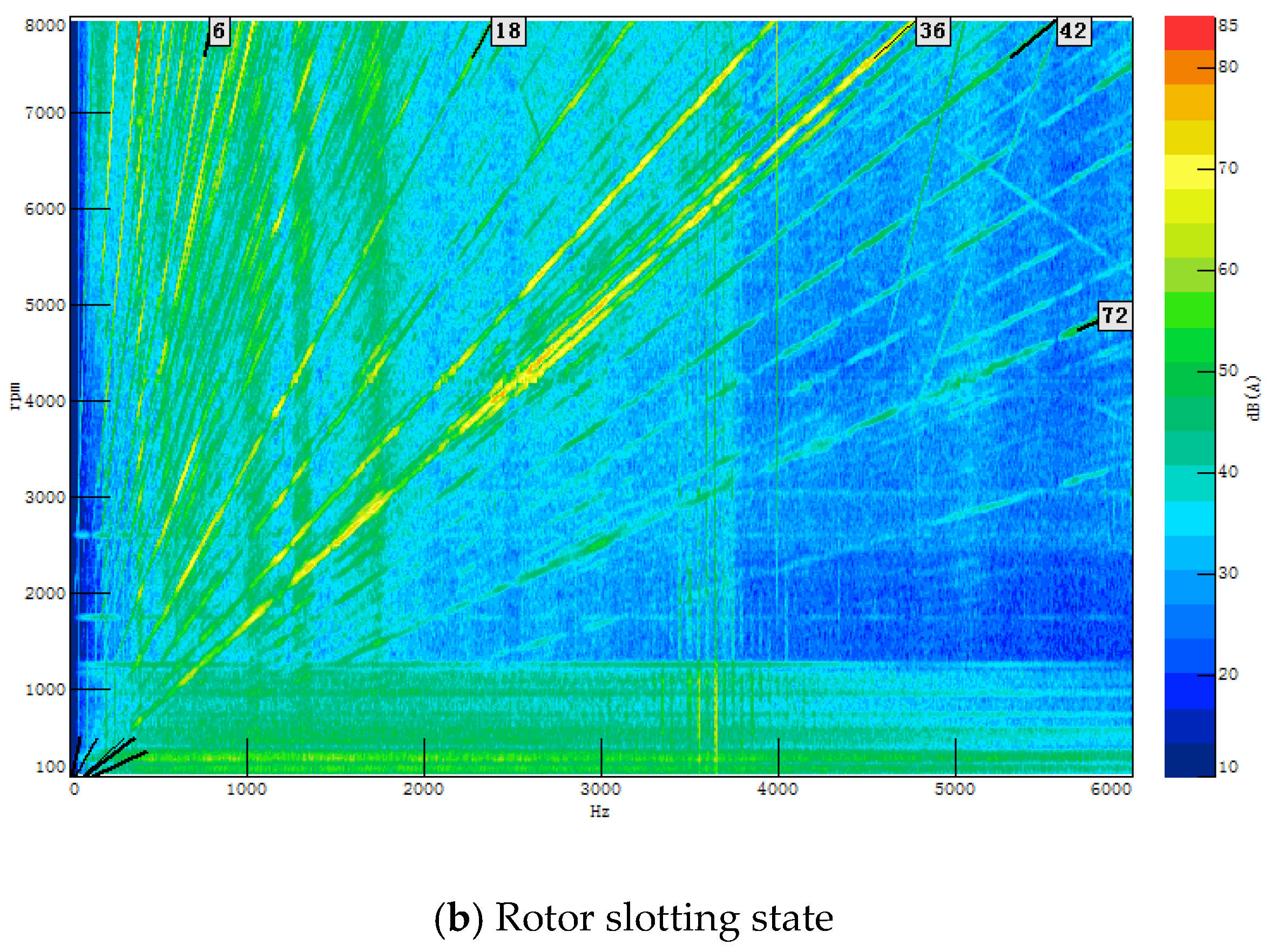A relative permeance function for the slotted machine was proposed in [
5] to modulate the radial component of flux density distribution predicted by the slotless model, which has received extensive applications in the surface permanent magnet motor (SPMM) for predicting radial force. In [
6,
7,
8,
9], radial electromagnetic force is calculated by the finite element method, and the influence of radial electromagnetic force on noise and vibration is studied. The pole-slot combination of PMSM is one of the key issues affecting its NVH. In [
10,
11,
12,
13], the air gap magnetic flux density and electromagnetic force were obtained by the finite element method to study the influence of the pole-slot combination of the motor on vibration and noise. In [
14], by coupling the analysis model with the finite element model, the hybrid model takes into account the permeability, slot height, and rotor shape, and calculates the complex global air-gap permeability per unit area, which makes the calculation of air-gap magnetic density with high accuracy and calculation speed. In [
15], it is proposed that the lower harmonic components of the radial electromagnetic force is mainly due to the interaction between the magnet field and the armature-reaction field, which is largely determined by the combination of the pole and slot numbers, and it is much more reliable to calculate the radial force in the middle of the air gap rather than close to the stator bore. Zuo et al. [
16] proposed that the electromagnetic force caused by stator slotting effect contributes most to the overall noise. In addition, with reducing the amplitude of the electromagnetic force, which is close to the resonant frequency by optimizing the slot width, the sound pressure level (SPL) is reduced by 6 dB (A). It is also raised in the paper that to reduce the vibration and noise of the motor, optimizing the electromagnetic force or increasing the structural stiffness both works. However the latter is costly, so the most widely used method is to avoid the electromagnetic force appearing near the modal frequency. In [
17], a combined simulation of electromagnetic field, mechanical field, and acoustic field was applied to predict the vibration and noise of a three-phase 12-pole 36-slot claw pole alternators. Simulation results agree well with the results measured by experiments. Results show that the vibration and noise of the motor is mainly caused by the electromagnetic force of spatial order 0 and order 6. In [
18], in order to reduce the rated unbalanced magnetic force, three 3-slot/2-pole permanent magnet (PM) motors with different auxiliary slots were studied and compared. A 2D finite element method is introduced, and its unbalanced magnetic force characteristics are analyzed, and the unbalanced magnetic force with different auxiliary slots is studied. It is mentioned in [
19] that reducing harmonic components of the air gap flux density can effectively attenuate the cogging torque and suppress the torque ripple, thereby reducing motor vibration. This goal is achieved in the paper by the means of optimizing the shape of the permanent magnet and the shape of the rotor surface. In [
20], a slotted rotor configuration is proposed to reduce the torque ripple and radical vibration force. The flux density distributions are discussed to explain the principle that the torque ripple and radical vibration of motor is smaller with a slotted rotor and skew-slot stator.
In this paper, a 6-pole 36-slot vehicle PMSM is studied. The spatial order and frequency order of the electromagnetic force of the motor are analyzed. In addition, the motor is optimized by rotor slotting to weaken the electromagnetic force and improve the motor NVH performance. This paper provides a new NVH optimization idea, that is, first of all, the mechanism analysis of the problematic electromagnetic order noise is decomposed, and the related harmonics are decomposed. Under the premise that other factors are unchanged, reducing the amplitude of these harmonics can achieve the purpose of optimizing the electromagnetic order noise. This method can quickly locate the fundamental problem location of electromagnetic NVH, provide a fast channel for electromagnetic NVH optimization from simulation to verification, and improve the optimization efficiency of NVH.
















